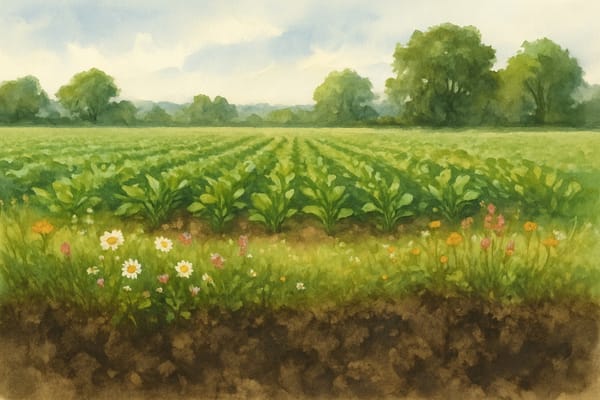Soil is more than just the stuff we dig through in the garden or rinse off our boots after a walk. In Cornwall, it’s the foundation of almost everything — our food, our rivers and coastlines, our wildflowers and woodlands, and even our climate resilience. But beneath the surface, hidden from view, a quiet revolution is taking place. Scientists around the world — and increasingly here in the UK — are discovering just how alive and intelligent soil really is.
In 2025, new breakthroughs have revealed a world of microbes, root systems, and digital tools that are transforming how we understand and care for the ground beneath us. And Cornwall, with its unique geology, small-scale farming, and nature-based values, stands to benefit in remarkable ways.
The Deep Soil Secret: Microbes That Clean Cornwall’s Water
Beneath Cornwall’s granite hills and moorlands, where the bedrock meets deep, dark soil, something extraordinary is happening. Scientists have discovered a previously unknown group of microbes — tiny living organisms — thriving far underground in what’s called the “Critical Zone.” This is the layer of Earth that stretches from the surface down to the rocks, where water, air, soil, and life all interact.
These microbes (known as the CSP1-3 group) aren’t just surviving in the dark, oxygen-poor depths. They’re thriving. In some places, they make up nearly half of all life in these deep soils — and they’re busy doing something important: cleaning and recycling.
As rainwater trickles down through layers of soil, it carries with it leftover nutrients and pollutants. The CSP1-3 microbes act like a natural filtration system, breaking down what’s harmful and turning it into something safe. The result? Cleaner groundwater. In a place like Cornwall, where many homes and farms rely on wells or natural springs, this microbial clean-up crew could be a hidden hero of water quality.
Even more, these deep-soil microbes help lock carbon in the ground and recycle nitrogen — both crucial for healthy ecosystems. And because Cornwall’s soils are often thin and quick-draining, especially on moorland and upland farms, keeping nutrients in place and protecting water supplies has never been more important.
Plant Roots That Think for Themselves
Above the microbes, something else remarkable is happening — right at the tips of plant roots. New research shows that roots aren’t just passive straws sucking up water. They’re more like sensitive scouts, able to sense changes in their surroundings and respond at a cellular level.
If the soil becomes compacted, salty, or dry, roots activate a hormone called abscisic acid (ABA), which helps them adapt. It’s a bit like a plant putting up its defences when it senses a storm is coming — it strengthens cell walls, limits damage, and prepares for the stress ahead.
In Cornwall, where soils can be rocky, shallow, or unexpectedly waterlogged, this ability to sense and adapt is key. It explains how native wildflowers like thrift, gorse, and sea campion manage to survive on windswept cliffs or boggy heathland. It also opens the door to developing food crops that are better suited to our local conditions — saving water, improving yields, and helping gardens and farms thrive even in difficult seasons.
Imagine being able to see exactly where a field is drying out, or where nutrients are lacking, without digging a single hole. In 2025, farmers can. Thanks to satellites and AI, soil can now be mapped from space. Multispectral cameras pick up data we can’t see with our eyes — like moisture levels or organic matter — and software turns it into real-time advice. It’s like giving land managers a bird’s eye view of their soil’s health, every day.
In Cornwall, this is especially useful. Many farms are small, family-run, and scattered across mixed terrain — some sandy, some clay-rich, some facing the Atlantic’s harsh winds. AI tools help pinpoint exactly where action is needed, so water and fertiliser aren’t wasted and soil stays protected.
At the same time, scientists are developing new “living amendments” for soil — natural blends of beneficial microbes, biochar (a kind of plant-based charcoal), and organic matter. Field trials in the UK have shown that just one application can double water retention in sandy soil. For Cornwall’s lighter soils, this could be transformative — making fields more drought-resilient and reducing reliance on synthetic fertilisers.
And it’s not just farmers who benefit. These tools are already being used in conservation projects across the UK, including wildflower meadow restorations, wetland recovery, and vineyard soil regeneration — all practices with growing relevance in Cornwall’s countryside.
Counting Carbon: New Ways to Track Soil’s Role in Climate and Nature Recovery
Healthy soil isn’t just good for plants — it’s a powerful climate ally. As organic matter builds up, it stores carbon, keeping it out of the atmosphere where it would otherwise contribute to global warming. But until recently, measuring this “soil carbon” accurately was difficult and inconsistent.
Now, monitoring tools have caught up. Using a combination of lab tests, satellite data, and AI modelling, landowners can track how much carbon is stored in their soil — and how that changes over time. This matters for Cornwall, where peatlands, moorlands, and regenerative farms all have the potential to be part of the UK’s nature-based climate solutions.
Better measurement also means better support. Farmers and estate managers can access carbon markets and government funding based on results, not just promises. For smallholders or community growers, this could become a new way to earn income while doing right by the land.
A Cornish Perspective: Who’s Leading the Way
Across the county, people are already applying these ideas. Conservation groups in West Cornwall are using AI mapping to monitor the success of hedgerow restoration and pollinator meadows. Farmers in the Camel Valley and around St Austell are trialling organic soil amendments to cope with increasing summer droughts. At the Eden Project, cutting-edge labs are now open for training, research, and soil science innovation.
These stories are just beginning to be told — but they show what’s possible when ancient landscapes meet new science, and when soil is treated not as dirt to be moved, but as a living system to be understood.
Looking Ahead: Challenges and Cornish Opportunities
Of course, challenges remain. Cornwall’s soils are some of the oldest in Europe and are naturally low in nutrients. Climate change brings more erratic rain, stronger storms, and longer dry spells — all of which stress soil systems. But there’s also hope.
Cornwall has something special: a long tradition of land stewardship, strong community ties, and a growing number of farmers, growers, scientists, and citizens who care deeply about its future. With the right tools and knowledge, the county is well placed to lead in sustainable land use, clean water protection, and low-impact food growing.
The Living Landscape Beneath Our Feet
The discoveries of 2025 have made one thing clear: the ground beneath our feet is far more alive, intelligent, and valuable than we ever imagined. Whether it’s microbes cleaning water deep below Bodmin Moor, roots sensing drought in a coastal field, or AI satellites guiding a vineyard near Penzance, the science of soil is now central to Cornwall’s future.
If we protect it, invest in it, and learn from it, our soils will return the favour — with cleaner water, stronger crops, more biodiversity, and a landscape resilient to the changes ahead.








